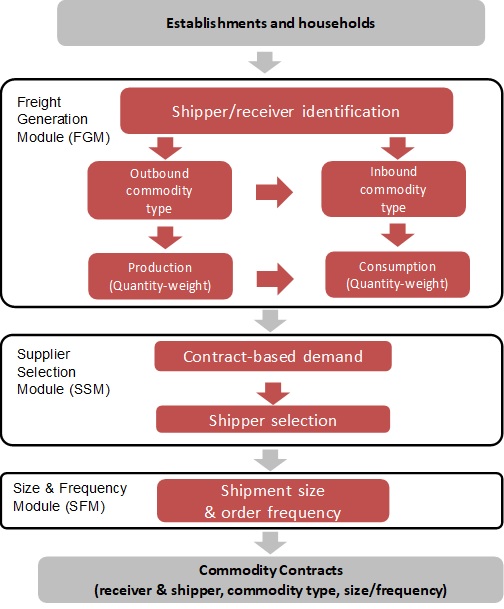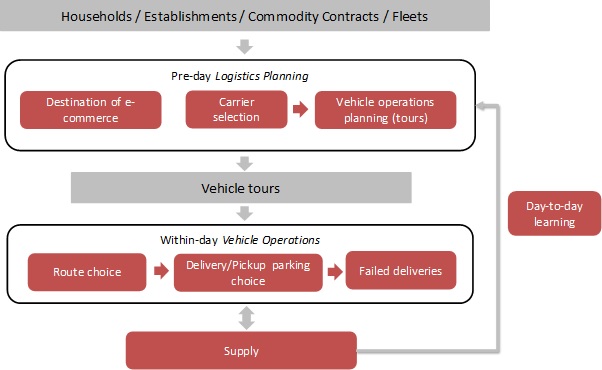Project Manager(s):
Andre Romano Alho, Lynette Cheah, Moshe Ben-Akiva
Sponsor:
Singapore National Research Foundation
Team:
Andre Romano Alho, Takanori Sakai, Yusuke Hara, Zhiyuan Chua, Chu Yaw Tai, Rayden Chua, Wen Han Chong, Peiyu Jing, Lynette Cheah, Giacomo Dalla Chiara, Raja Gopalakrishnan, Rakhi Manohar Mepparambath, Moshe Ben-Akiva
Start Date:
January 2015
Research Highlights:
• SimMobility Freight is an agent-based urban freight simulator and one of main components of SimMobility.
• The disaggregate modelling system of SimMobility Freight allows for the analysis of various types of city logistics measures and agent-specific impacts.
• SimMobility Freight applies the state-of-the-art freight modelling practices in its components for predicting commodity contracts, logistics planning, and vehicle operations.
Abstract:
SimMobility Freight, an urban freight simulator, is one of the main components of SimMobility. The core components of SimMobility Freight predict commodity contracts, logistics planning, and goods vehicle behaviors. Its disaggregate formulation allows for measuring the impacts of changes in various logistics operations dimensions, for example, supplier locations, shipment size, vehicle availability, consolidation/deconsolidation, delivery time window, and vehicles' operation patterns. Together with the other components in SimMobility, it supports the analysis of various types of policy measures, including emerging “smart” logistics practices, and their impacts as well as interactions between freight and passenger traffic flows.
Description:
I. OVERVIEW
The structure of SimMobility Freight follows the three temporal dimensions of SimMobility. The long-term (LT) model simulates commodity contracts and goods vehicle overnight parking based on the data of establishments, goods vehicles, and the “overnight” parking supply. The mid-term (MT) model has three components, simulating “pre-day” logistics planning, “within-day” goods vehicle operations, and traffic movements (mesoscopic traffic simulation), respectively, based on commodity contracts and goods vehicle population. The simulation system of the short-term (ST) model is the same for both passenger and freight vehicle movements; it conducts the micro-simulation of vehicle behaviors on the road network, with detailed replication of them.

Figure 1. SimMobility Freight Conceptual Framework
II. COMMODITY CONTRACT ESTIMATION IN LONG-TERM MODEL
A commodity contract defines the origin and destination of a commodity flow, commodity type, contract size, and shipment size and frequency. Commodity contracts determine commodity flows and are the main inputs for simulating goods vehicle behaviors. The estimation of commodity contracts consists of three steps: freight generation, supplier selection, and shipment size/frequency choice. Three modules are developed for the three steps: Freight Generation Module (FGM), Shipper Selection Module (SSM), and Size & Frequency Module (SFM) (Figure. 1). The main input to the simulation is the list of establishments located in the study area, with the details of employment, floor area, industry type, and function type. SimMobility LT model has a functionality that constructs the synthetic population of establishments based on various statistics available to public agencies.
The model considers three levels of units for commodity flows. The simulation starts from the annual quantity, i.e. the annual total amount for an establishment to ship (or supply) or receive. The annual quantities shipped and received are called, “production” and “consumption” respectively, following the commonly used definitions in freight simulations. This annual quantity can be translated into one or more contracts. Each “contract” is associated with a shipper-receiver pair. Once established, a contract can be translated into “shipments”, the smallest unit, by estimating the size of shipments. A shipment is the fundamental dimension and represents the amount of goods that is transported together at the same time between a shipper and a receiver. The three modules in the commodity contract estimation correspond to these levels of units, respectively.
III. MID-TERM MODEL
The overview of the three components, “pre-day” logistics planning, “within-day” goods vehicle operations, and a mesoscopic traffic simulation (Figure 2) is provided as follows.

Figure 2. Process of the Mid-term simulation
“Pre-day” logistics planning
The objective of logistics planning module is to convert the shipments derived from commodity contracts to “vehicle operations plans”, which define the movements (i.e. tours and trips) of goods vehicles, including stop locations, activities associated with the stop locations (pick-up, delivery, overnight parking, etc.), and expected arrival and departure times. The logistics planning process includes modules for carrier selection and vehicle operations planning. The carrier selection module selects carrier(s) for each “outsourcing shipper”, which requires third-party carriers for its shipments, based on the distance from the shipper and goods vehicle availability. The vehicle operations planning module matches shipments with goods vehicles, makes an order of pickups/deliveries and generates the vehicle operations plans. The links between vehicle operations plans and shipment records are preserved throughout a simulation, and therefore, the relationships between vehicle trips and shipments are identifiable. Ongoing enhancements include the considerations of receiver time windows and collaborative urban consolidation schemes among others.
“Within-day” goods vehicle operations and mesoscopic traffic simulation
The models of goods vehicle operations bridge the vehicle operations plans to a mesoscopic traffic simulation. The route choice model predicts the route a driver takes for each trip (i.e. a movement from one location to another), given traffic conditions. The delivery/pickup parking choice model, on the other hand, predicts the parking choice depending on parking infrastructure availability and/or suitability and conditions such as waiting time.
The “supply” mesoscopic traffic simulator simulates traffic movements on a road network, which has a hierarchical structure with the information of links, segments (each link connects two nodes and consists of multiple segments), and lanes. By considering the two types of traffic status, moving and queuing, as well as the details of road and parking infrastructures (e.g. bus stops and loading/unloading bays), the simulator allows of a detailed and realistic simulation of traffic movements.
References:
Journal papers
- Sakai, T. (SMART), B. K., B. (SMART), Alho, A. (SMART), Hyodo, T. (TUMST), Ben-Akiva, M. (MIT) (2018), “Commodity Flow Estimation for a Metropolitan Scale Freight Modeling System: Supplier Selection Considering Distribution Channel Using an Error Component Logit Mixture Model”, Transportation, pp. 1-29.
- Alho, A. (SMART), B. K., B. (SMART), Stinson, M. (MIT), Gopalakrishnan, R. (SUTD), Le, D. T. (SMART), Ben-Akiva, M. (MIT) (2017), “A Multi-scale Agent-based Modelling Framework for Urban Freight Distribution”, Transportation Research Procedia 27, 188-196.
Conference papers
- Sakai, T. (SMART), Alho, A. (SMART), B. K., B. (SMART), Dalla Chiara, G. (SUTD), Gopalakrishnan, R. (SUTD), Jing. P. (MIT), Hyodo, T. (TUMST), Cheah, L. (SUTD), Ben-Akiva, M. (MIT), “Modeling Freight in SimMobility, A Multi-scale Agent-based Urban Simulation Platform”, Submitted to World Conference on Transport Research - WCTR 2019.
- Sakai, T. (SMART), Alho, A. (SMART), Hyodo, T. (TUMST), Ben-Akiva, M. (MIT), “Modelling Shipment Size for Urban Freight Simulations”, Submitted to the 11th International Conference on City Logistics, 2019.
- Alho, A. (SMART), Sakai, T. (SMART), Hara, Y. (SMART), Raven, M. (MIT), Jing, P. (MIT), Jeong, K. (MIT), Ben-Akiva, M. (MIT), “A Comparison of Tour-formation Models and Reproducibility of Freight Vehicle Flows in the Context of an Agent-based Urban Freight Modelling System”, Submitted to the 11th International Conference on City Logistics, 2019.
- Gopalakrishnan, R. (SUTD), Alho, A. (SMART), Sakai, T. (SMART), Lynette Cheah (SUTD), Ben-Akiva, M. (MIT), “An Agent-based Simulation of Overnight Truck Parking in Cities”, Submitted to the 11th International Conference on City Logistics, 2019.
- Jing, P. (MIT), Zhang, Y. (MIT), Jeong, K. (MIT), Alho, A. (SMART), Ben-Akiva, M. (MIT). "Modeling Daily Tour-Chaining Pattern Choice of Urban Heavy Commercial Vehicles", the 97th Annual Meeting of the Transportation Research Board, Washington D.C., January 7-11, 2018.
- Sakai, T. (SMART), B. K., B. (SMART), Alho, A. (SMART), Hyodo, T. (TUMST), Ben-Akiva, M. (MIT). “Modeling Freight Generation, Commodity Contracts, and Shipments for SimMobility Freight – A Disaggregate Agent-Based Urban Freight Simulator”, Submitted to the 98th Annual Meeting of the Transportation Research Board, 2019. Accepted.
- Alho, A. (SMART), Sakai, T. (SMART), B. K., B. (SMART), Le, DT. (SMART), Ben-Akiva, M. (MIT), “A Multi-Scale Agent-based Modelling Framework for Urban Freight Distribution”, the 7th International Conference on Innovative in Travel Modeling, Atlanta, Georgia, June, 2018.
- Sakai, T. (SMART), B. K., B. (SMART), Alho, A. (SMART), Hyodo, T. (TUMST), Ben-Akiva, M. (MIT). “Urban Freight Distribution considering Logistics Chain Structure: Selection of Supplier with Distribution Channel”, the 97th Annual Meeting of the Transportation Research Board, Washington D.C., January 7-11, 2018.

